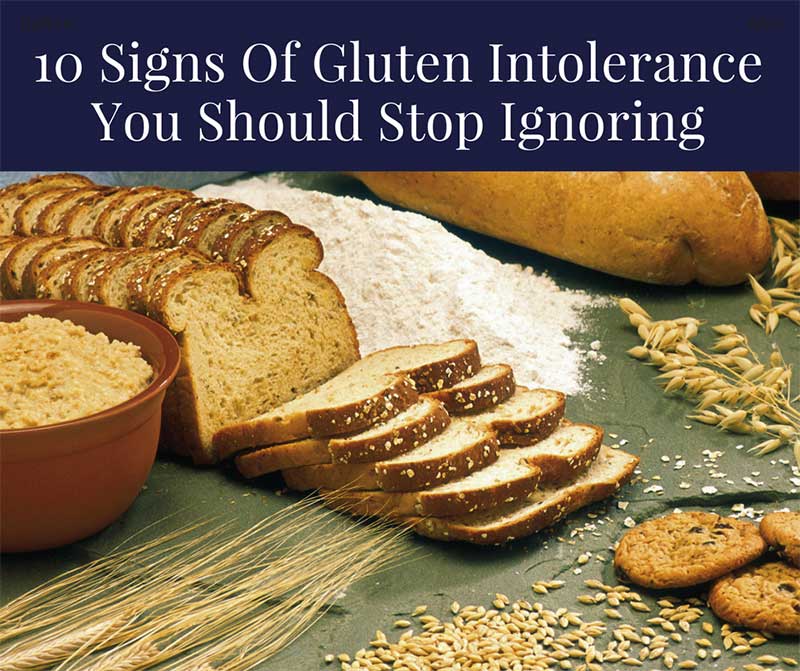10 Signs Of Gluten Intolerance You Should Stop Ignoring
Gluten intolerance is more common now than ever before. Gluten intolerance is a manageable condition, but people wait years to be diagnosed. Other people have the warning signs of gluten intolerance, but they never seek a diagnosis. People treat the symptoms of gluten intolerance rather than discovering the gluten is their true problem.
There is a large difference between gluten intolerance and Celiac disease. You can have an intolerance without having Celiac disease. Intolerances don’t show up in blood work, so tracking signs and symptoms is the only way to determine if gluten is your issue.
Skin Problems
Gluten intolerance tends to cause different skin issues that you cannot explain otherwise. Pimples, a flushed complexion, acne and random rashes that appear out of nowhere are some common issues. Most of these rashes occur on the knees, back, elbows, buttocks, and back of the neck. Typically, the rashes are itchy as well.
Keratosis Pilaris, often referred to as chicken skin, might develop on the back of your arms. This rash is due to a fatty acid and vitamin A deficiency because gluten damages their gut. Keratosis Pilaris looks like goosebumps, but it doesn’t go away. While it is harmless, note that it is a common sign.

Migraines and Brain Fog
Migraines can make you feel horrible. Both migraines and brain fog can indicate gluten intolerance. Brain fog makes it hard for you to remember tasks or to concentrate throughout the day. Migraines can incapacitate you, leaving you incapable of doing your daily tasks.
Numb Extremities and Joint Pain
People experience joint pains all of the time, but most never think the joint pains are due to gluten intolerance. Believe it or not, numb extremities and joint pain are common signs of gluten intolerance, but people rarely attribute it first to that problem!
You might note that your limbs often feel as if they fall asleep or are on pins and needles. The joint pain feels similar to arthritis and is caused by inflammation. You might experience inflammation in your knees, finger, and hips.
Bloating and Stomach Pain
One of the most common signs of food intolerance is bloating and stomach distension. If eating food that contains gluten leads to intestinal discomfort, gluten might be the problem.
No one enjoys a belly ache; you’ll feel rather uncomfortable.
Constipation, Diarrhea, and Gas
Bloating and belly aches aren’t the only intestinal symptoms you might experience. Anyone with food intolerances can deal these three symptoms. If these become frequent, you should track your signs and see if there is a pattern. A food journal allows you to determine if the signs occur when you consume gluten food.
Constipation is frequent in children who have issues with gluten. Foul-smelling stool and nausea after you consume gluten-laden foods also might mean that your body is trying to tell you it disagrees with gluten.
Mood and Hormonal Issues
Moodiness is a common complaint for those with gluten intolerance. It can be more than moodiness though. Some people experience depression, anxiety, and other mood issues that is unexplainable. Part of the problem can be lack of sleep, but your moods can change day by day or even throughout the day.
Hormonal issues can also be a symptom to understand. Some doctors wonder if gluten intolerance could lead to polycystic ovarian syndrome, premenstrual syndrome, and infertility. Gluten intolerance leads to an inflamed body, which can make reproduction harder for males and females.
Neurological Symptoms
Along with brain fog, gluten intolerance can cause other neurological symptoms. Some symptoms can make it difficult for you to function normally. You might feel as if you are off-balanced or lose coordination often. People with gluten intolerance experience episodes of dizziness frequently. The neurological symptoms may appear within an hour of eating food containing gluten.
Fatigue and Fibromyalgia
Everyone has periods of time when you feel tired and sluggish. Those with gluten intolerance may experience fatigue more frequently, even if you are getting a full night’s rest. Gluten may be the culprit because it can interfere with your sleep pattern. Your body may not be able to get the sleep needed.
Fibromyalgia is a chronic issue that causes pain throughout your muscles, ligaments, and tendons. It is most commonly diagnosed in women.
An Autoimmune Disease
Perhaps the most serious sign is a diagnosis of an autoimmune disease. Many scientists and doctors believe that there is a direct correlation between gluten intolerance and autoimmune disease. Rheumatoid arthritis, lupus, scleroderma, myasthenia gravis, ulcerative colitis, psoriasis and multiple sclerosis are frequently diagnosed in those who cannot tolerate gluten.
Lactose Intolerance
If you are lactose intolerance, it can make a gluten intolerance worse. If you know that you have issues with lactose, keep an eye on those other symptoms. Foods containing lactose have a sugar element that triggers other digestive issues. Because of this, you might notice issues with gluten as well.
How to Determine if You are Gluten Intolerant
If you think you have signs of gluten intolerance, the best thing to do is an elimination diet. During an elimination diet, you take gluten out of your diet for two to three weeks. Then, reintroduce it at a meal.
It is important to remember that gluten, just like dairy, can take months to get out of your system. You might have to do a longer elimination diet. You may feel so much better once you remove gluten from your diet that you decide never to reintroduce it!
Watch for Signs of Gluten Intolerance
The signs of gluten intolerance are wide and varied, making it hard to diagnose the problem. If you are wondering if gluten is causing a problem for your system, check out how many of these warning signs you have.
An elimination diet can help you determine if gluten is causing a problem in your intestinal system. Remember that it can take several weeks for gluten to leave your system entirely. Until it is gone, you might still experience some signs and discomfort.
 Home and Gardening Ideas At home and Gardening ideas we believe inspiring readers about homesteading, self sufficiency
Home and Gardening Ideas At home and Gardening ideas we believe inspiring readers about homesteading, self sufficiency








